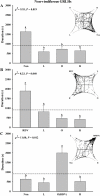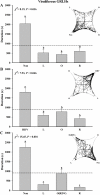Rice dwarf virus infection alters green rice leafhopper host preference and feeding behavior
- PMID: 30192810
- PMCID: PMC6128522
- DOI: 10.1371/journal.pone.0203364
Rice dwarf virus infection alters green rice leafhopper host preference and feeding behavior
Abstract
Host plants, pathogens and their herbivore vectors systems have complex relationships via direct and indirect interactions. Although there are substantial gaps in understanding these systems, the dynamics of the relationships may influence the processes of virus transmission and plant disease epidemics. Rice dwarf virus (RDV) is mainly vectored by green rice leafhoppers (GRLHs), Nephotettix cincticeps (Uhler) (Hemiptera: Cicadellidae) in a persistently circulative manner. In this study, host plant selection preferences of non-viruliferous and viruliferous (carrying RDV) GRLHs between RDV-free and RDV-infected plants were tested. Non-viruliferous GRLHs preferred RDV-infected rice plants over RDV-free rice plants, and viruliferous GRLHs preferred RDV-free rice plants over RDV-infected rice plants. In odor selection preference bioassay using a four-field olfactometer, non-viruliferous GRLHs preferred odors of RDV-infected rice plants over healthy rice and viruliferous GRLHs preferred odors of RDV-free rice plants over RDV-infected ones. In 6 h plant penetration behavior bioassay using electrical penetration graphs, non-viruliferous GRLHs spent shorter time in non-penetration and much longer time in xylem feeding on RDV-infected, compared to RDV-free rice plants. Viruliferous GRLHs exhibited more salivation and stylet movement on RDV-free rice plants than on RDV-infected rice plants. We infer from these findings that RDV influences these vector behaviors by altering host plant physiology to promote viral transmission.
Conflict of interest statement
The authors have declared that no competing interests exist.
Figures








Similar articles
-
Virus-Induced Plant Volatiles Promote Virus Acquisition and Transmission by Insect Vectors.Int J Mol Sci. 2023 Jan 16;24(2):1777. doi: 10.3390/ijms24021777. Int J Mol Sci. 2023. PMID: 36675290 Free PMC article.
-
Virus-induced plant volatiles mediate the olfactory behaviour of its insect vectors.Plant Cell Environ. 2021 Aug;44(8):2700-2715. doi: 10.1111/pce.14069. Epub 2021 May 5. Plant Cell Environ. 2021. PMID: 33866575
-
Combined influence of Bt rice and rice dwarf virus on biological parameters of a non-target herbivore, Nephotettix cincticeps (Uhler) (Hemiptera: Cicadellidae).PLoS One. 2017 Jul 28;12(7):e0181258. doi: 10.1371/journal.pone.0181258. eCollection 2017. PLoS One. 2017. PMID: 28753622 Free PMC article.
-
Rice Reoviruses in Insect Vectors.Annu Rev Phytopathol. 2016 Aug 4;54:99-120. doi: 10.1146/annurev-phyto-080615-095900. Epub 2016 May 25. Annu Rev Phytopathol. 2016. PMID: 27296147 Review.
-
Behavioural aspects influencing plant virus transmission by homopteran insects.Virus Res. 2009 May;141(2):158-68. doi: 10.1016/j.virusres.2008.10.020. Epub 2009 Jan 17. Virus Res. 2009. PMID: 19152819 Review.
Cited by
-
Delivery of Rice Gall Dwarf Virus Into Plant Phloem by Its Leafhopper Vectors Activates Callose Deposition to Enhance Viral Transmission.Front Microbiol. 2021 May 5;12:662577. doi: 10.3389/fmicb.2021.662577. eCollection 2021. Front Microbiol. 2021. PMID: 34025616 Free PMC article.
-
Virus-Induced Plant Volatiles Promote Virus Acquisition and Transmission by Insect Vectors.Int J Mol Sci. 2023 Jan 16;24(2):1777. doi: 10.3390/ijms24021777. Int J Mol Sci. 2023. PMID: 36675290 Free PMC article.
-
Ethylene signaling mediates potyvirus spread by aphid vectors.Oecologia. 2019 May;190(1):139-148. doi: 10.1007/s00442-019-04405-0. Epub 2019 May 8. Oecologia. 2019. PMID: 31065807
-
A Novel Iflavirus Was Discovered in Green Rice Leafhopper Nephotettix cincticeps and Its Proliferation Was Inhibited by Infection of Rice Dwarf Virus.Front Microbiol. 2021 Jan 8;11:621141. doi: 10.3389/fmicb.2020.621141. eCollection 2020. Front Microbiol. 2021. PMID: 33488564 Free PMC article.
-
Cry1C rice doesn't affect the ecological fitness of rice brown planthopper, Nilaparvata lugens either under RDV stress or not.Sci Rep. 2020 Oct 2;10(1):16423. doi: 10.1038/s41598-020-73465-7. Sci Rep. 2020. PMID: 33009432 Free PMC article.
References
Publication types
MeSH terms
Supplementary concepts
LinkOut - more resources
Full Text Sources
Other Literature Sources

